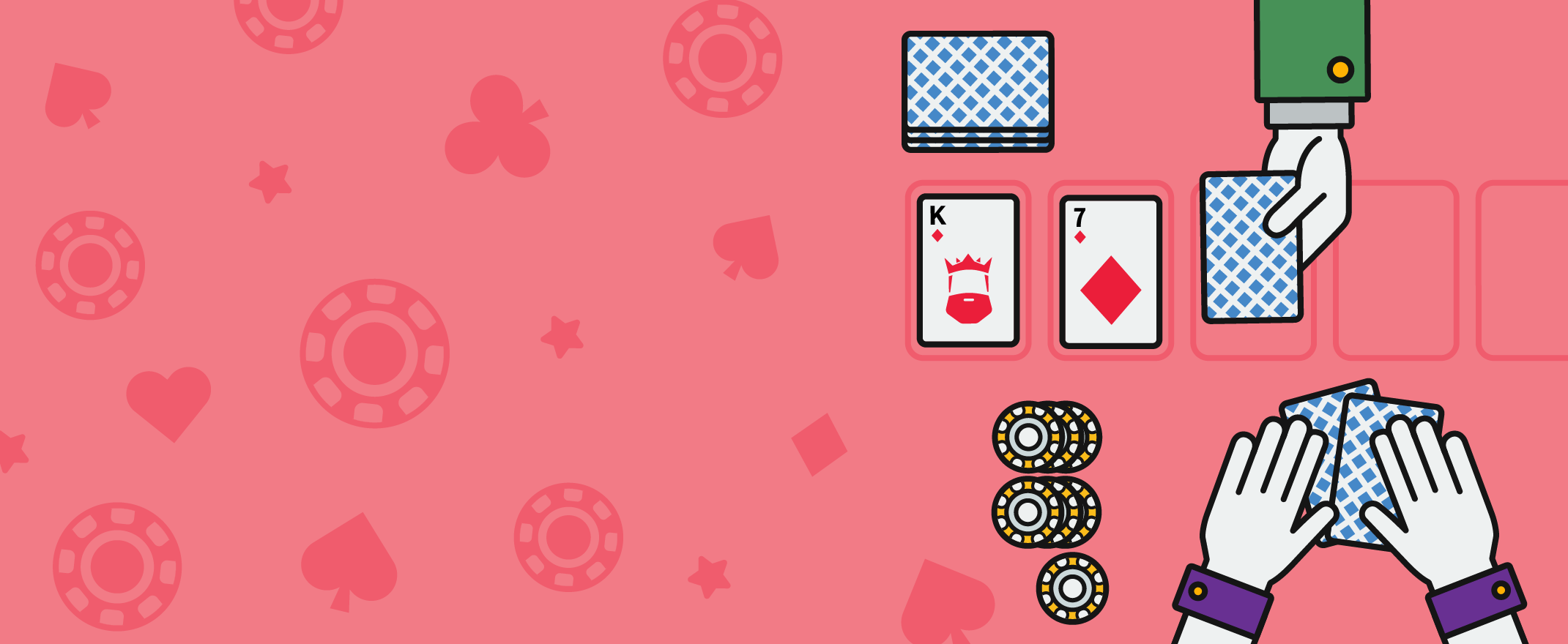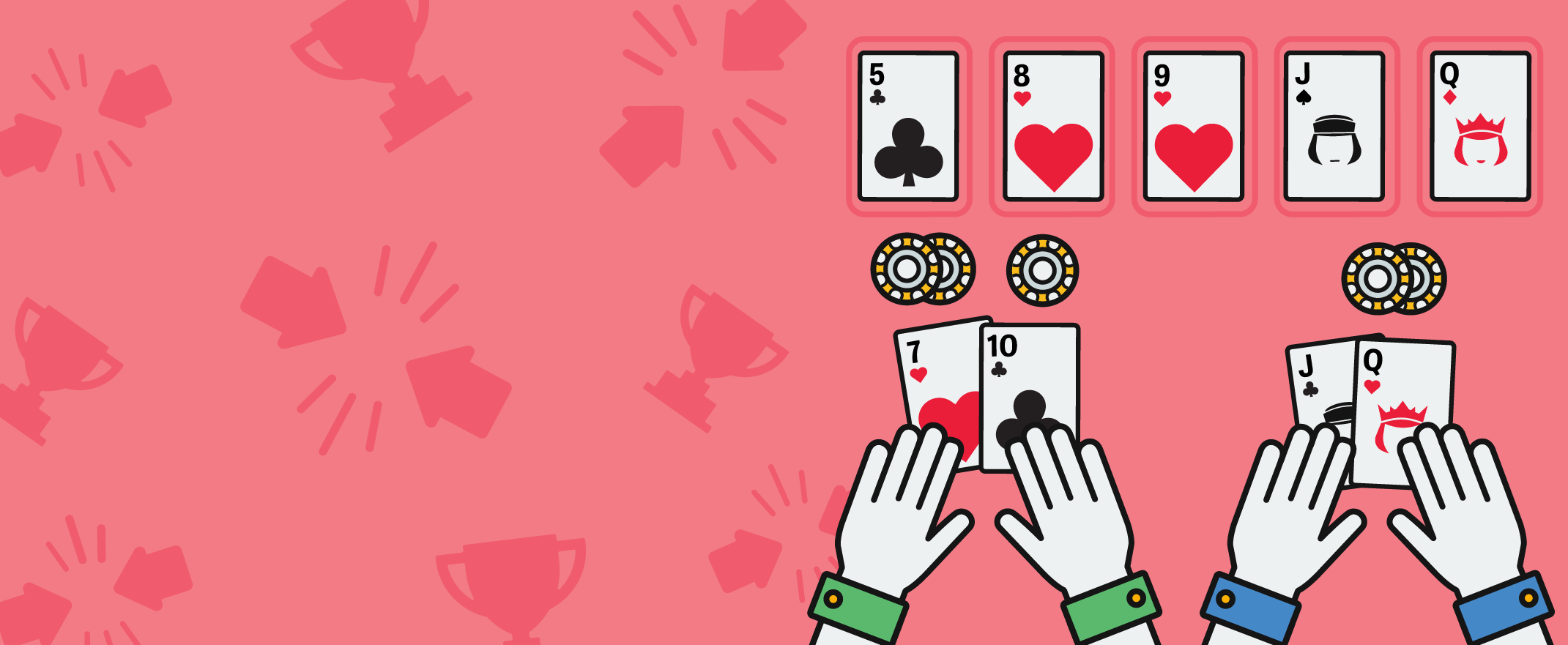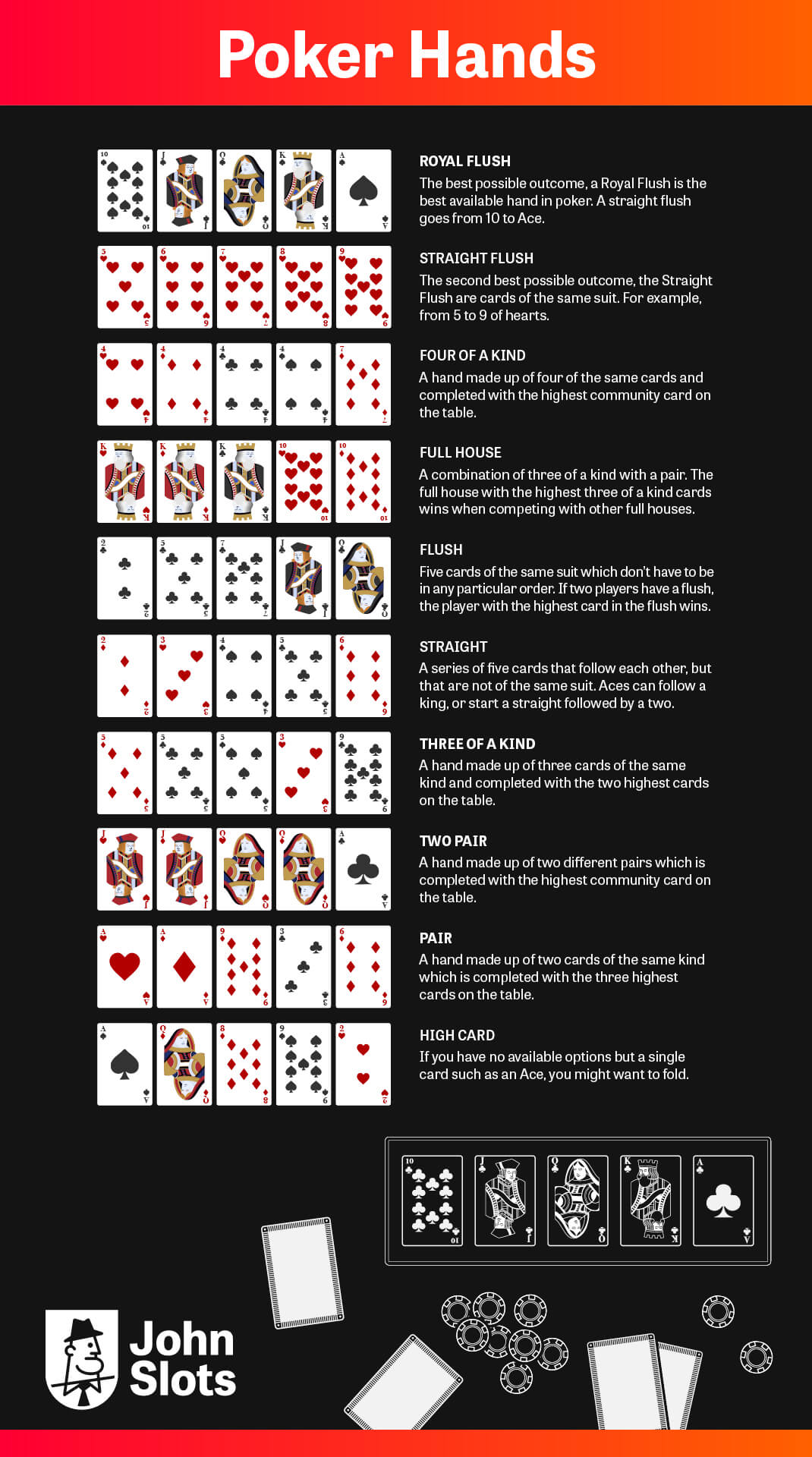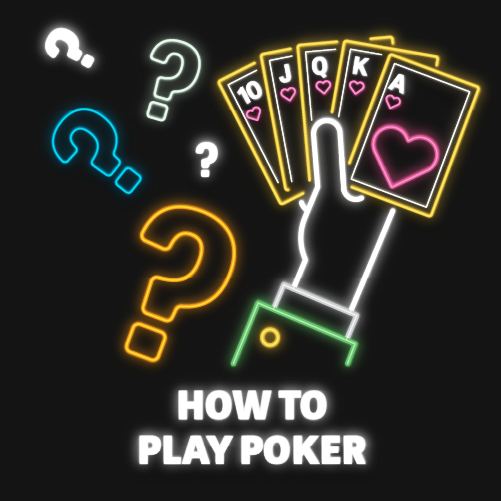Read on to learn about different types of poker games, the most important poker-related phrases, and how to improve your poker skills.
Different poker variants
Many casino games, whether online or in real life, can appear with slightly different variations in rules, setup or other aspects. Poker has several variants, the most popular and well known being Texas Hold’em. Others include Omaha, 7-Card Stud, Caribbean Stud and other exotic-sounding variants.
Each type will have its own rules, which we have expanded on in our guide to online poker rules. Because this page is all about how to play poker for beginners, we are going to focus on the most popular version of poker, which is Texas Hold’em.
Texas Hold’em rules
Texas Hold’em poker, also known as simply Hold’em, can be played by between 2 and 10 players at the same table, all competing for chips, which can then be exchanged for real cash. Players make wagers using chips, which are added to the pot.
Each round of poker is called a hand and the objective is to win the pot at the end of the hand by forming the best set of five cards possible.
In the next sections, we will talk you through the way the cards are dealt, the different kinds of cards you might receive and what actions you can take during a hand of poker.
Keep in mind that these rules remain the same whether you are playing Texas Hold’em poker online or in a land-based casino – though the medium may be different, the game itself is played the same way.
Your position around the table
One player acts as the dealer and they are identified by a marker called the Button. In poker rooms and at the best online casinos, a professional dealer is hired to do the dealing itself but the button is still used to keep track of the play.
The button moves around the table in a clockwise direction. The two players to the left of the dealer are called blinds.
The position of the six players at a poker table would be as follows:
- The player who has the dealer button
- To the left of the dealer button, there’s the ‘small blind’
- Then there’s the ‘big blind’
- After the ‘big blind’, there’s the ‘under the gun’ who is the first player to play before the flop
- Then there’s the ‘hijack’
- Finally, there’s the ‘cut off’, which is the last position in which a loose raise is acceptable
When a poker player is said to be ‘having position’, they usually mean to being last to act on that street, since in this manner, the player has all the available information before opting for a decision, while the other opponents have to act without knowing.
Early position
The two blind seats, the small blind and the big blind are in ‘early position’. Similarly, the players in the two seats to the left of the big blind are also considered to be in ‘early position’.
The player which is ‘under the gun’ is also considered to be in ‘early position’ since he is the first player to act in the pre-flop betting round and has no information on the intentions of his opponents yet.
Players in this position thus need to have very strong hands to enter the pot since they will have little information from their opponents and have to act the earliest.
Middle position
This position is for those players who are seated between the ‘Under the Gun’ player and the dealer’s right.
Players in this position can have looser starting hand requirements than those in the early position since there are fewer poker players to their left who still have to act. It is, however, quite risky to enter a pot from this position as the players in the late position have a better advantage.
Late position
The strongest position to be in, the ‘late position’ is reserved for those seats on the right-hand side of the dealer known as the ‘cut off’ and the dealer. These positions are said to be the best since players can monitor all the action and collect the most information.
If everyone else has folded and you have an average hand, you can still win the pot straight away. You can also raise with a lot more cards such as an Ace while the other card is of the same suit and suited connectors.
Understanding Blinds
No, these have nothing to do with the things you roll down over the living room windows. The two players seated to the left of the dealer are called the small blind (directly adjacent to the dealer) and the big blind, which is the player sat to the left of the small blind.
These two players are forced to place bets to open up the wagering. Without these blind bets, the game would be rather boring because players would only bet when they were dealt with good hands. By requiring the blinds to put money in the pot, there is something to be won during every hand.
The small blind has to post a smaller bet than the big blind, with the former generally being half of the latter. So the small blind might bet £1 whereas the big blind would bet £2.
This can vary between poker rooms, and during tournaments, the blinds are raised at certain intervals as players drop out and the remaining players have large stacks of chips to play with. During cash games, the blind amounts usually remain the same.

When should you fold, call or raise?
If you’ve watched any casino-related movies, you will be familiar with these phrases, which players call out at certain points in the game.
Fold
Let’s say you have been dealt a hand of cards you do not like the look of. You can fold, which means you relinquish all of your cards and do not participate any further in the present hand. Any chips you have contributed to the pot remain where they are i.e. you cannot take them back.
Once you have folded, your cards are placed in the ‘muck’, which is made up of other cards discarded during that round. You cannot retrieve any cards once they have been placed in the muck.
Deciding when to fold can be tough, especially for new players. Keep an eye on your opponents and learn to figure out their betting habits. It’s important to be familiar with the pot odds and to trust your instincts.
Call or raise
A player who has been dealt a hand they want to keep in play can either call or raise. A player who calls indicates that they want to match the amount bet by the last player to see the next card or, if the last dealt card was the river card, to see the showdown.
A player who is particularly confident about their hand can raise, which means they want to increase the wager and force the original bettor to match that wager if they want to continue playing.
Understanding the betting rounds
These terms (and a few others we will elaborate on in a minute) are an important part of the play during the betting rounds. This is a time when players can study one another’s betting patterns, weigh up their options and the odds of winning.
Aside from folding, calling and raising, players can also bet or check. If you like the look of your cards (or want to give the impression that you do), you can simply place your chosen chips in the centre of the table in front of you. Players who want to continue playing must match your bet or increase it in order to stay in the game.
When a player checks, they are putting off their bet for the moment. Another player may step in and bet, at which point the first player can choose to fold, call or raise their bet. If none of the players bet on that round, another card is dealt and the first player can then choose whether to bet or check once again.
To summarise, when it is your time to bet, you have the following options to make:
- Fold: To quit the game
- Bet: Place a bet and continue playing
- Check: Neither folding not betting but a Pass
- Call: To match the current bet
- Raise: To exceed the current bet
With these terms sorted, we will move on to the betting rounds proper. There are four in total and are followed by the showdown.
Preflop
This is the first round of betting and consists of the two blind bets. When a player makes a blind bet, it is sometimes referred to as ‘posting’ the bet.
The Preflop takes place when the only cards that have been dealt are the hole cards – the two cards dealt face-down to each player, which only the player may see. Players may fold, call or raise at this time.
The Flop
This amusingly named round is when the dealer deals the three community cards in the middle of the table. Only players who have not folded in the preflop round can play from this point forward.
Players can choose to bet, fold, call, raise, or check and this will continue clockwise until the last bet or raise has taken place. If all the players choose to check, the betting round ends.
The Turn
On to round three! This is when the dealer puts the fourth community card on the table, beside the three dealt in the previous round.
Another round of betting follows, which follows the same rules as the previous round i.e. players can call, fold, raise or check.
The River
The last betting round follows the dealing of the fifth community card, which is called the River. It is dealt face up next to the four other community cards and players may take the same actions as in the previous rounds by betting, calling, folding, checking or raising.
Once all the bets have been made (or not made), the players move on to the showdown, which determines who has the best set of cards.

Understanding the Showdown
The hand culminates in the showdown, when players reveal their cards, find out who has the best combination and who will take home the pot of chips. Card combinations are ranked in value and the player with the highest value hand at the table will be the winner.
The following is a list of hands, in order of decreasing value, and the cards that form them.
- Royal Flush: A, K, Q, J, 10 of the same suit
- Straight Flush: Five cards in a sequence, all of the same suit
- Four of a Kind: Four cards of the same rank, not necessarily in the same suit
- Full House: Three of a kind, plus a matching pair
- Flush: Any five cards of the same suit
- Straight: A Straight is a hand that is made up of consecutive ranks, such as 5, 6, 7, 8, 9. An Ace in this game is counted as 1 when needed to complete a straight.
- Three of a kind: Three cards of the same rank
- Two pair: Two pairs of matching cards
- A Pair: A Pair is a hand that is made up of two cards of the same rank, such as 8, 8, 4, 3. A pair beats a high card even if the pair in question is lower than the rank in the high card. So if you have a pair of twos, they will still beat a high card.
- High Card: If no other player has a hand from the other hands in this list, the highest card wins. The highest cards can be from the lowest to the highest starting from Jack, Queen, King and Ace. For example, a hand that is made up of a King, 8, 4, 3 and 2 beats the hand made up of Queen, 8, 4, 5 and 2 since the King always beats the Queen. If two players have the same high cards then the second-highest card wins.
All the suits are of the same value i.e. hearts have the same value as clubs or spades.
However, cards do have different ranks, shown here in order of descending value: Ace, King, Queen, Jack, 10, 9, 8, 7, 6, 5, 4, 3, 2. So if a player has Four of a Kind made up of Kings, their hand is more valuable than a hand made up to four 7s and the former would win if it came down to those two players.

How to become a better player
Playing poker is relatively easy once you have understood the rules but as with any skill-based game, there is plenty of scopes to improve those skills.
In this beginner’s guide to poker, we have covered the basic Texas Hold’em rules and our other guides, such as the guide to poker rules and poker strategies, cover the nuance that serious players will be interested in.
1. Read poker books and articles
Reading articles and poker books is a good way for you to learn more. You will learn some strategies and theories that would have taken professional players many years of playing the game in a few hours.
2. Practise
Like most things in life, practice makes perfect in poker and the best way to practice is to play, play and play some more. This is where free or demo play becomes invaluable, allowing you to put your new knowledge into practice without risking any of your hard-earned cash in real games.
3. Test out some strategies
Once you have figured out the rules and memorised those hands, it’s time to test out some strategies. There are a plethora of resources out there that guide players through different betting strategies, giving concrete examples to illustrate.
Again, free play versions are a great way to test these strategies out and see which one suits you best.
4. Fold more often
Probably one of the biggest mistakes many poker players make is that they play too many hands. When starting, you want to play poker and that usually means staying in hands in order to be part of the action.
Playing more does not lead to more wins. It usually means losing more often.
5. Don’t bluff for the sake of bluffing
Many newbies know that bluffing is a very integral part of poker but don’t quite know when they should be bluffing.
Bluffing only works in specific situations and against a certain type of player. If you know that a player always calls at showdown, you cannot bluff that player.
6. Pay attention to your opponents
Once you have mastered the game, the next most important thing to remember is to always observe your opponents even when you are not in a hand.
If you notice that a player is always raising in a specific position, you can use this information to help you decide how to play against them.
7. Play at your skill level
If you want to be the best at the poker table, don’t play at a table where you are playing against experts. Find a table where your opponents are on the same skill level as you are for your best chance to win.
Summary
Poker has fairly simple rules but the element of community play ensures that each hand is unpredictable and exciting. By playing with others, you are guaranteed a unique experience every time.
This guide aims to give you a foundation to build on, allowing you to develop your skills and explore new strategies by equipping you with the basics.

Frequently asked questions about playing poker
Here you’ll find answers to some of the questions beginners often ask about poker.
What is the easiest poker game to learn?
Texas Hold’em is the most popular variant for a reason. It has the most straightforward rules and many other variations build on them. So if you understand Hold’em, you are already at least partly familiar with other kinds of poker.
Is poker played clockwise or counterclockwise?
The Button, which signifies the dealer, moves clockwise around the table. Betting too follows a clockwise pattern.
How much money do you start with in poker?
This varies depending on the player and the context, ranging from £10 to £10,000 if you are playing in a tournament. Some games have a buy-in amount.
How do you know if a poker hand is good?
By knowing the value of your hole cards, you can create combinations with the community cards. If your hole cards are very low value, your hand may be poor.
Which hands should you play in poker?
The truth is that not every hand is a winner and part of getting better at poker is learning when to fold. Only the Royal Flush is completely unbeatable so unless you have one of those, you should be asking yourself how your hand stacks up against what your opponent might be holding.
What’s the best full house in poker?
The Full House is made up of three of a kind and a matching pair. The best combination you can get is three Aces and a pair of Kings.
What is a kicker?
Also called a side card, the kicker is a card that does not contribute directly to the rank of the hand but can be used as a tiebreaker.
For example, a hand consisting of Q-Q-10-5-2, where 10, 5 and 2 are kickers, would win over a hand of Q-Q-10-4-3, because the 5 is of higher value than the 4.
What is a Blind?
A Blind is one of two players who are forced to make a bet before any community cards are drawn. This ensures that there are always chips in play.
Can I show my hole cards to my opponents before the showdown?
No. You can only reveal your cards during the last round.
How is the pot calculated in a pot-limit game?
The pot limit is a betting structure wherein the player may raise or bet any amount between a set minimum bet and the current size of the whole pot.
This is calculated through a formula that includes the last wager (L) made, the starting pot size (S), the maximum bet (M) and the action before the previous bet or trail (T), as follows: (3L+T)+S=M
What is the maximum amount of bets and raises in a fixed-limit poker?
Fixed-limit poker games, unlike No Limit or Pot Limit games, have specified limits for bet sizes that players must abide by.
Usually, Fixed Limit games have two bet sizes – small and big bets – and players can only bet on those amounts. A game described as ‘2/4’ has a small bet of £2 and a big bet of £4.
What happens when someone bets more than I have at the table?
If someone bets more than you can in one round, you can go All-in, which means that you can continue to play as long as you bet all your available chips. A player can never be bet out of his hand simply because he does not have enough to call.
Can I buy more chips instead of going All-in?
For the most part, casinos will allow you to buy more chips mid-game but you will not be able to use them until the following round.
Casino Game Specialist
6+ Years of Experience

Statistics
34 Articles
Harper Gallagher is a respected specialist in online casino games, particularly craps, poker and casino table games. By staying abreast of emerging technologies and trends, she inspires others to pursue their own passions in the exciting world of online casino gaming.
Expert On:



